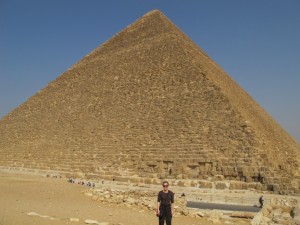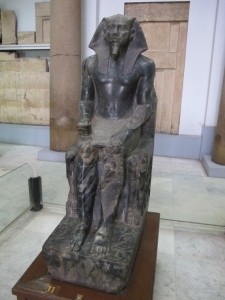 We began our Egypt/Jordan tour with a huge bang. Our first stop was the Egyptian Museum. Under one immense roof (and several impressive domes) one finds the greatest collection of ancient antiquity anywhere in the world. Room after room of statuary, stele, columns, sarcophagi, papyrus, canopic jars, mummies, and artifacts. It is a rich but daunting collection. I recall my first trip to Egypt back in the 90s. I remember being impressed with the collection here, but also getting quickly bored by the sheer numbers and “unenlightened” repetition. I say unenlightened, because the difference of having an articulate, well-educated guide is immeasurable. Our hand-picked guide Hoda was in her element. She is a trained Egyptologist and her explanations made each room and statue come alive with the story of Egypt.
We began our Egypt/Jordan tour with a huge bang. Our first stop was the Egyptian Museum. Under one immense roof (and several impressive domes) one finds the greatest collection of ancient antiquity anywhere in the world. Room after room of statuary, stele, columns, sarcophagi, papyrus, canopic jars, mummies, and artifacts. It is a rich but daunting collection. I recall my first trip to Egypt back in the 90s. I remember being impressed with the collection here, but also getting quickly bored by the sheer numbers and “unenlightened” repetition. I say unenlightened, because the difference of having an articulate, well-educated guide is immeasurable. Our hand-picked guide Hoda was in her element. She is a trained Egyptologist and her explanations made each room and statue come alive with the story of Egypt.
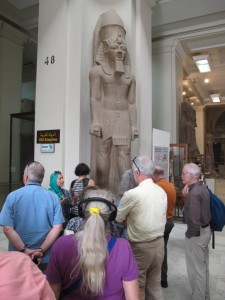 We began with the Stele of Narmur, the famous carved shield with the hieroglyphs of Narmur, the king who first united upper and lower Egypt in 3000BCE. We continued on to see examples of statuary from all the dynasties, Hoda explaining the various reasons for changes in style. For example, Akhennaten, father of famous Tut, is depicted with both male and female features. He was attempting to push Egypt toward mono-theism. As the kings (pharaohs by now) were seen as divine, their likenesses needed to reflect attributes of the gods. So he wanted his image to reflect a single deity, which would of course be both man and woman.
We began with the Stele of Narmur, the famous carved shield with the hieroglyphs of Narmur, the king who first united upper and lower Egypt in 3000BCE. We continued on to see examples of statuary from all the dynasties, Hoda explaining the various reasons for changes in style. For example, Akhennaten, father of famous Tut, is depicted with both male and female features. He was attempting to push Egypt toward mono-theism. As the kings (pharaohs by now) were seen as divine, their likenesses needed to reflect attributes of the gods. So he wanted his image to reflect a single deity, which would of course be both man and woman.
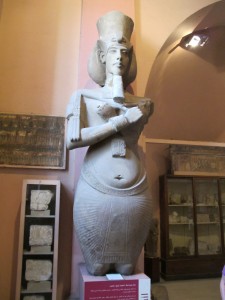 The conclusion and climax of our tour was the Tutankhamen exhibit. Howard Carter’s famous 1922 discovery of an intact tomb is a story that most people know. I need not describe the exquisite death mask, perhaps the most iconic image of Egypt. But of course there were chariots, walking sticks (he was lame), weapons, chairs and furniture, boats, jewelry, sarcophagi, and even gilded houses – all to aid Tut in the afterlife. The value of the Tut’s trove is inestimable to our appreciation of the rulers of ancient Egypt. We learned from Hoda that when a man became Pharoah he started building his tomb immediately. The tomb was not only the vehicle of his surviving and flourishing in the afterlife, but also reflected his earthly legacy. So Tut, who died at about age 18, was only king for a few years. Yet the richness of his tomb appointment is staggering by any standard. It seems almost impossible to imagine the wealth one would have found in the tombs of some of the longer ruling Pharoahs.
The conclusion and climax of our tour was the Tutankhamen exhibit. Howard Carter’s famous 1922 discovery of an intact tomb is a story that most people know. I need not describe the exquisite death mask, perhaps the most iconic image of Egypt. But of course there were chariots, walking sticks (he was lame), weapons, chairs and furniture, boats, jewelry, sarcophagi, and even gilded houses – all to aid Tut in the afterlife. The value of the Tut’s trove is inestimable to our appreciation of the rulers of ancient Egypt. We learned from Hoda that when a man became Pharoah he started building his tomb immediately. The tomb was not only the vehicle of his surviving and flourishing in the afterlife, but also reflected his earthly legacy. So Tut, who died at about age 18, was only king for a few years. Yet the richness of his tomb appointment is staggering by any standard. It seems almost impossible to imagine the wealth one would have found in the tombs of some of the longer ruling Pharoahs.
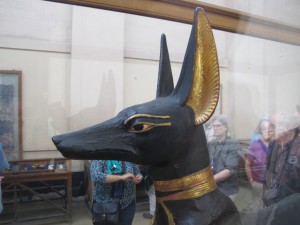 As is always the case on a guided tour for Imprint, once we were finished with Hoda we were given free time to explore and photograph on our own. Maia and I headed to the famous Mummy Room. Maia had studied Egypt in 6th grade and specifically remembers learning about mummification. The collection is not large but it is truly impressive. Impressive because they have been able to identify so many of the storied kings of ancient times: Seti I, Ramesses II, Ahmenhotep, Tutmosis, and others are all preserved in hermetically sealed glass cases. Those sleeping kings would be happy to know their attempts to achieve immortality have been successful – at least until the 21st century.
As is always the case on a guided tour for Imprint, once we were finished with Hoda we were given free time to explore and photograph on our own. Maia and I headed to the famous Mummy Room. Maia had studied Egypt in 6th grade and specifically remembers learning about mummification. The collection is not large but it is truly impressive. Impressive because they have been able to identify so many of the storied kings of ancient times: Seti I, Ramesses II, Ahmenhotep, Tutmosis, and others are all preserved in hermetically sealed glass cases. Those sleeping kings would be happy to know their attempts to achieve immortality have been successful – at least until the 21st century.
Before departing for lunch Hoda pointed out Tahrir Square which opens up in front of the museum. Here was the spot where the Arab Spring coalesced here in 2011 with huge protests and some violence. It was peaceful for our visit. Well, as peaceful as a major intersection can ever be in a city of 20+ million inhabitants.
As we began the afternoon on our first full day I think we all wondered how the visit could get any better than our first morning’s activity. We headed west to Giza for lunch after concluding our visit to Tahrir Square and the impressive Egyptian Museum. Hoda took us to a lovely restaurant with a view of the pyramids. But even those majestic structures couldn’t keep our attention from the business at hand – falafel, tahini, babaganoush, and other Egyptian “salads” started our feast. Then a mixed grill of chicken and beef kabobs filled our “travel tanks”.
Then it was on to the great pyramids. I have occasionally been under whelmed by famous sights in my travels. When that happens it is usually due to my expectations being unreasonably great. But I don’t believe any expectation, no matter how grandiose, could prepare one for the pyramids. The shear scale is enough to drop your jaw into the desert sand. 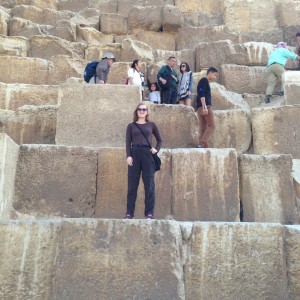 It staggers the mind to consider the gargantuan human effort required to construct anything this big – without the benefit of modern equipment. The scale is hard to appreciate until you are standing next to one of the behemoths. We took the obligatory tourist photo of Maia standing on the first row of gigantic block, each almost as tall as she. A handful of our group opted to go inside the Pyramid of Cheops while the rest of us resisted touts and camel drivers to find good photographic angles.
It staggers the mind to consider the gargantuan human effort required to construct anything this big – without the benefit of modern equipment. The scale is hard to appreciate until you are standing next to one of the behemoths. We took the obligatory tourist photo of Maia standing on the first row of gigantic block, each almost as tall as she. A handful of our group opted to go inside the Pyramid of Cheops while the rest of us resisted touts and camel drivers to find good photographic angles.
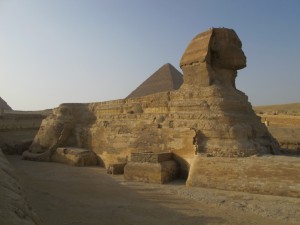 Our final tour stop of the day was the Great Sphinx. We learned that the nose is missing, not because French soldiers used it for target practice bur due to erosion. Not quite as juicy a story, but better to know the truth. The great human-faced cat was, of course, a royal monument to ego. The Pharoah Kephren who built it was representing his wisdom (the head of a man) and his strength (the body of a lion). The mother of all sphinxes was worn and crumbling, but she did not disappoint.
Our final tour stop of the day was the Great Sphinx. We learned that the nose is missing, not because French soldiers used it for target practice bur due to erosion. Not quite as juicy a story, but better to know the truth. The great human-faced cat was, of course, a royal monument to ego. The Pharoah Kephren who built it was representing his wisdom (the head of a man) and his strength (the body of a lion). The mother of all sphinxes was worn and crumbling, but she did not disappoint.
What a way to start the tour! The Egyptian Museum and King Tut, the Great Pyramids, and the Great Sphinx.

